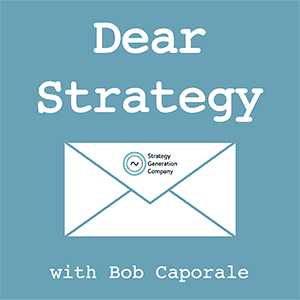Dear Strategy:
“How do I better assess what should be the trigger level for reviewing and potentially updating my strategy?”
When I listen back to the podcast episode for this question, I feel like I may have been a bit too cynical in my interpretation of the question. So, I’m going to use this forum, first to explain myself and then to actually answer the question!
If I were teaching a group of solopreneurs how to develop their strategies (which I do on a fairly regular basis, by the way), I would tell them to study as much formal strategic theory as they could, and then use those insights to help inspire a far more intuitive approach. That approach would essentially involve looking at what your customers need, designing a solution that nobody else has, and finding a way to deliver that solution in a way that can make some money. It would also involve having as a good a plan as can be mustered up, trying it out, and then retrenching if things aren’t going exactly as anticipated.
That doesn’t mean I endorse reckless trial and error with no research or data to back it up. But it does mean that I endorse embracing the fact that nothing is going to go exactly as you thought it would. So you need to give yourself the flexibility to take some risks and go back to the drawing board when and if the occasion calls for it.
Now let’s take that same approach and apply it into a large corporate environment where you have thousands of people who all have to make decisions on behalf of the company. Giving everyone that amount of intuitive flexibility would result in, at best, chaos, and, at worst, bankruptcy. So, in this case, a little more structure is needed.
OK – maybe a lot more.
And that’s how strategy frameworks are born – right along with annual strategic planning processes, quarterly strategy refresh processes, and the seemingly endless cadence of monthly review meetings that have become the trademarks of the large corporations that spawned them. And with all of this “structure,” it’s only natural that strategy owners working inside these large environments are going to be looking for “trigger points” from their leadership to tell them exactly when to create, review, and update their strategies in accordance with company expectations.
That was the assumption I made with regards to the origin of this question. And my answer is, that even though all this strategic structure exists for a reason, reviewing and updating your strategy based on internal trigger points is really the wrong approach.
“Reviewing and updating your strategy based on internal trigger points is really the wrong approach.”
No matter the environment you work in, your strategy is always going to be based on some level of assumptions. Maybe in large companies, those assumptions will be somewhat more data driven; and in smaller companies they may be based more on your gut feelings. But, either way, your assumptions are never going to be 100% correct. And when they’re wrong, they’re not going to be wrong on cue.
That means that the trigger for having to update your strategy isn’t going to be based on some predetermined timeline set by your management team, nor is it going to be based on some arbitrary financial threshold that you may or may not be meeting. Instead, it’s going to be based on the accuracy of your assumptions. In other words, when something happens that you didn’t accurately anticipate, you need to go back and revisit your strategy. That’s really the only trigger point you should be looking for.
Think of it like a game of chess. You plan out your moves based on what you think your opponent is going to do. But then he or she does something different. Do you stick to your plan? No – instead, you go back to the drawing board and revise your plan based on the new situation that you’re in.
Of course, you probably don’t want to go all the way back to the drawing board every time something happens that you didn’t anticipate. That’s why we recommend building your plan in layers – with a small number of high-level strategic initiatives sitting at the top of your plan, and a greater number of more granular tactical activities sitting below each of your initiatives. Taking this approach gives you the ability to vary your tactics without ever having to change your overarching initiatives. So, unless your assumptions are completely off, the basis of your plan should be able to stay, more or less, intact.
The long and short of it is, that your strategy is going to be revisited and updated all the time – either at a tactical level, a strategic level, or both. So, you shouldn’t wait for your annual, quarterly, or even monthly reviews to make a change. Instead, you should use those opportunities to update your leaders on what changes you’ve already made, and to let them know that your strategy is in good hands because you’ve never let it get out of your sight.
Listen to the podcast episode
Dear Strategy: Episode 099

###
Are you interested in strategy workshops for your product, marketing, or business managers? If so, please be sure to visit Strategy Generation Company by clicking the link below:
 Bob Caporale is the founder of Strategy Generation Company, the author of Creative Strategy Generation and the host of the Dear Strategy podcast. You can learn more about his work by visiting bobcaporale.com.
Bob Caporale is the founder of Strategy Generation Company, the author of Creative Strategy Generation and the host of the Dear Strategy podcast. You can learn more about his work by visiting bobcaporale.com.







